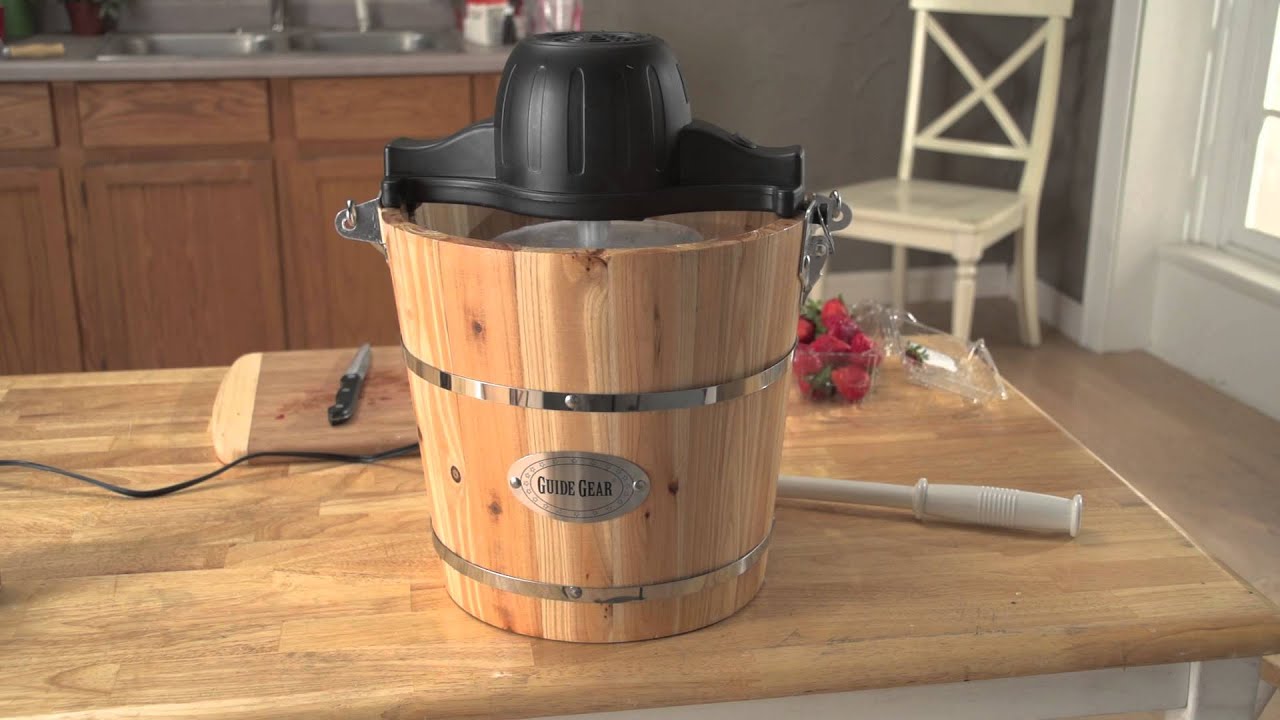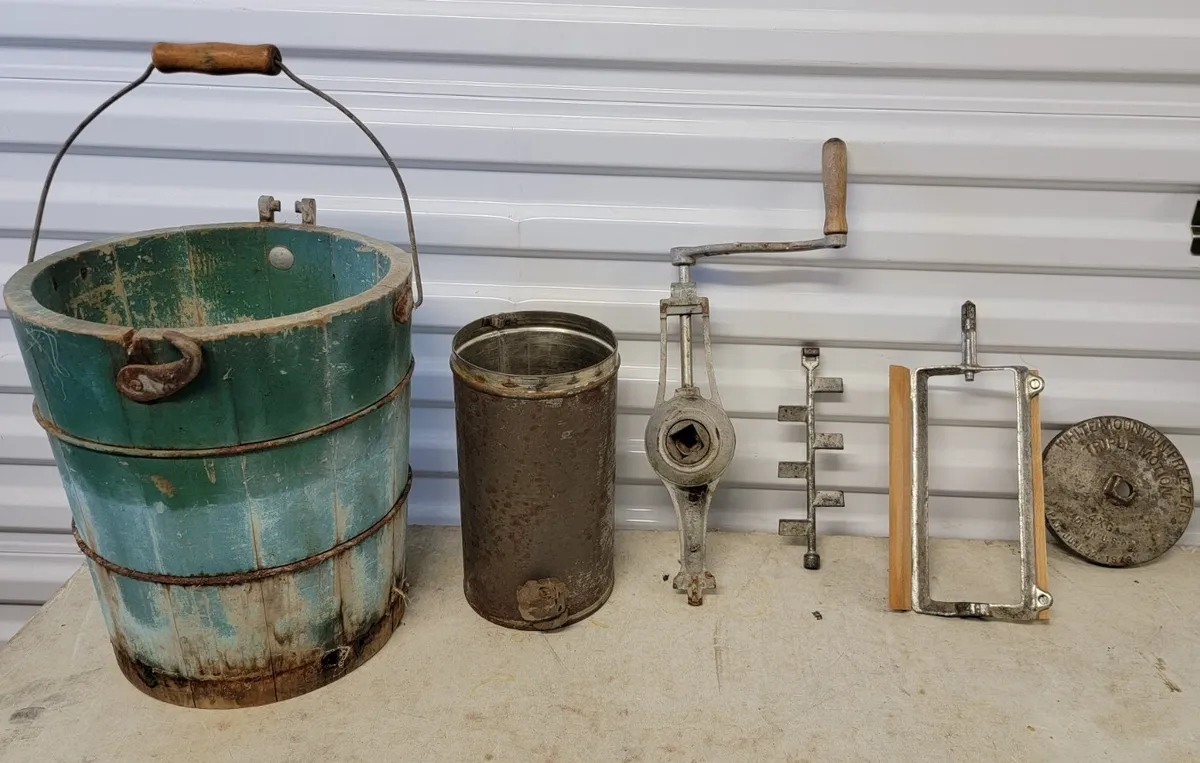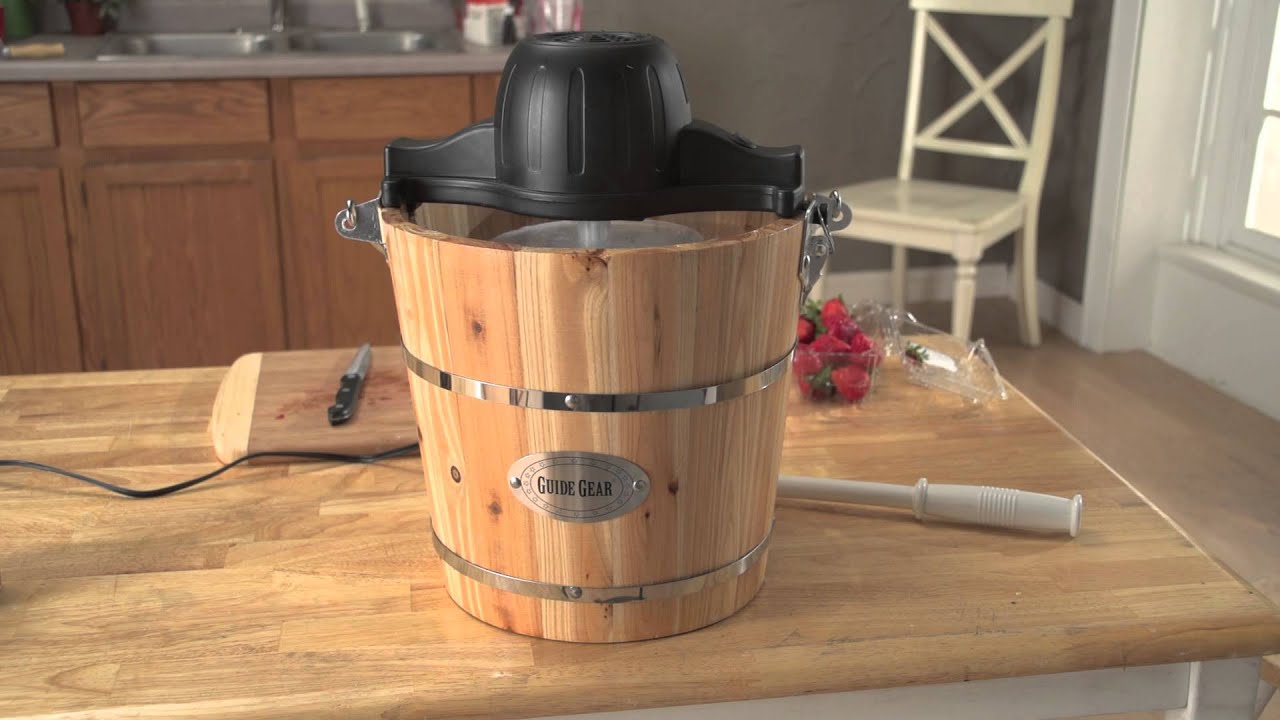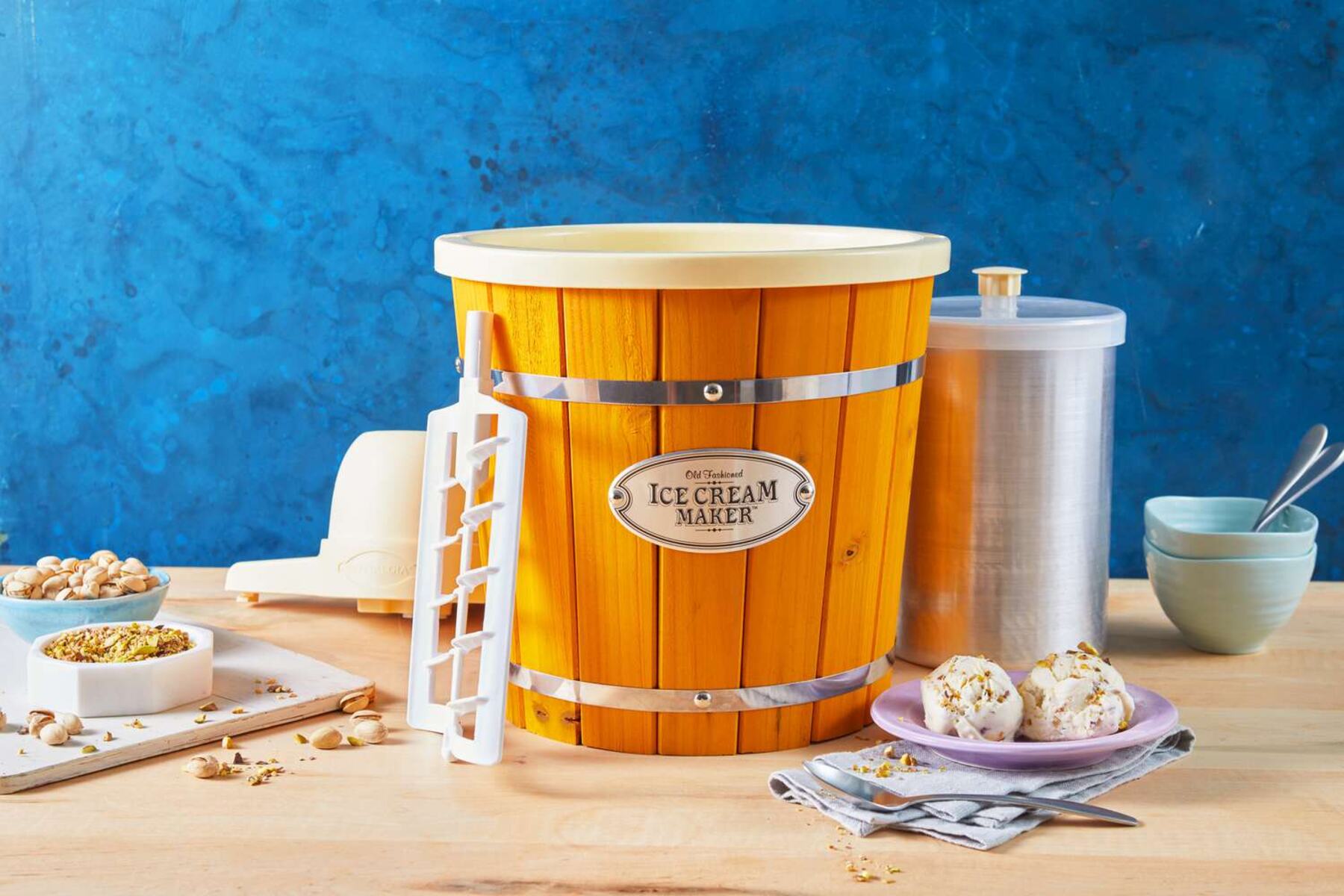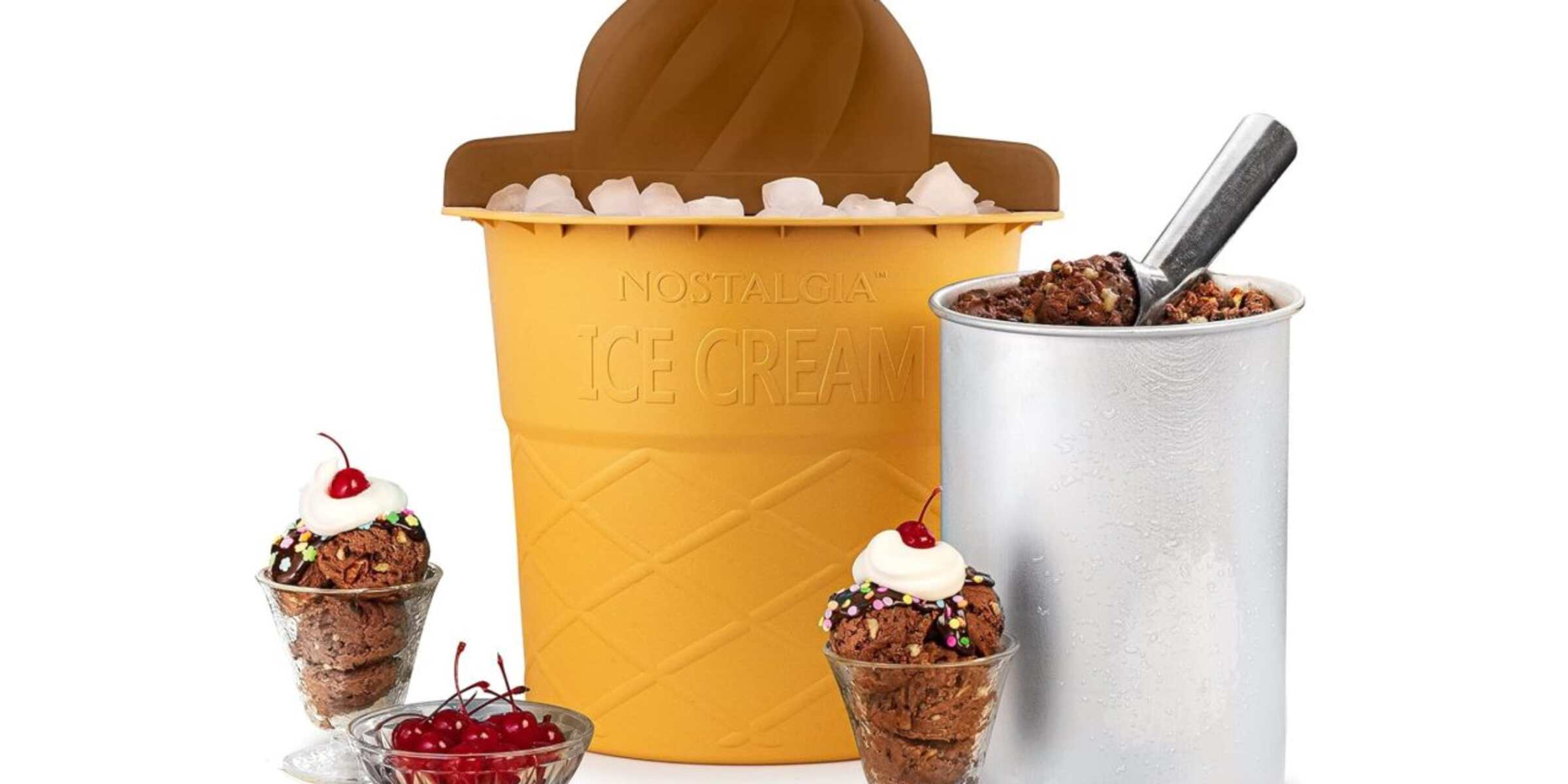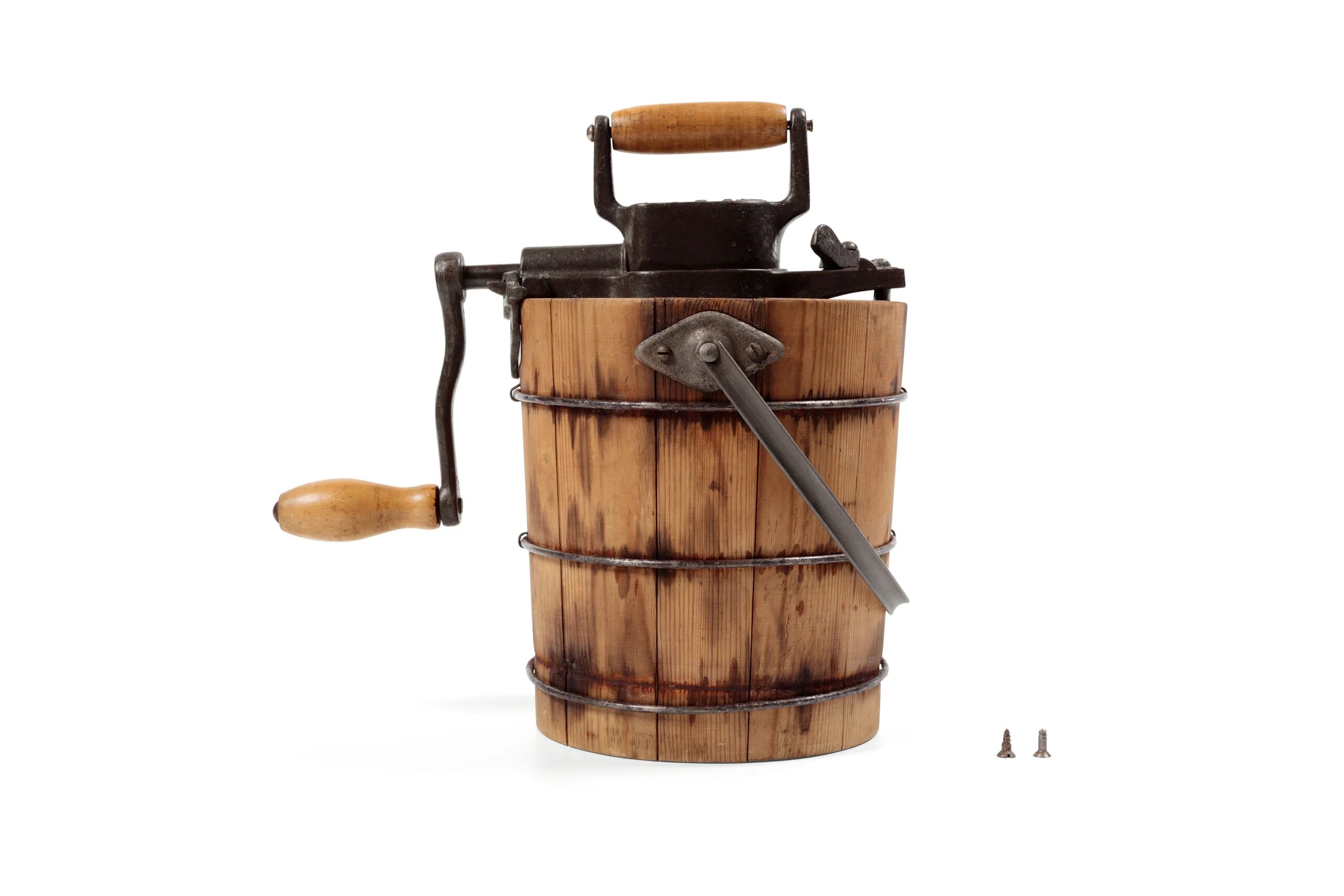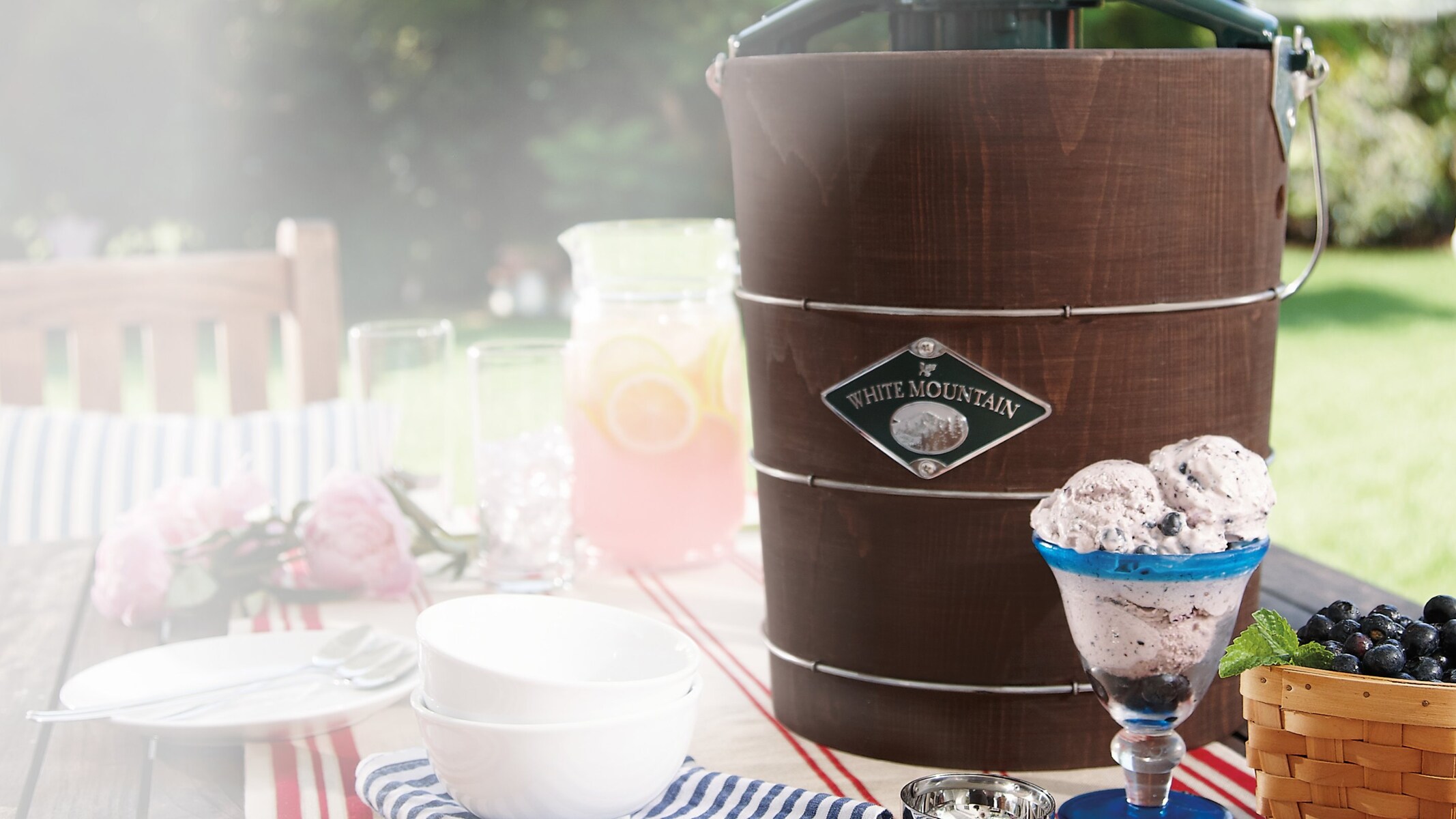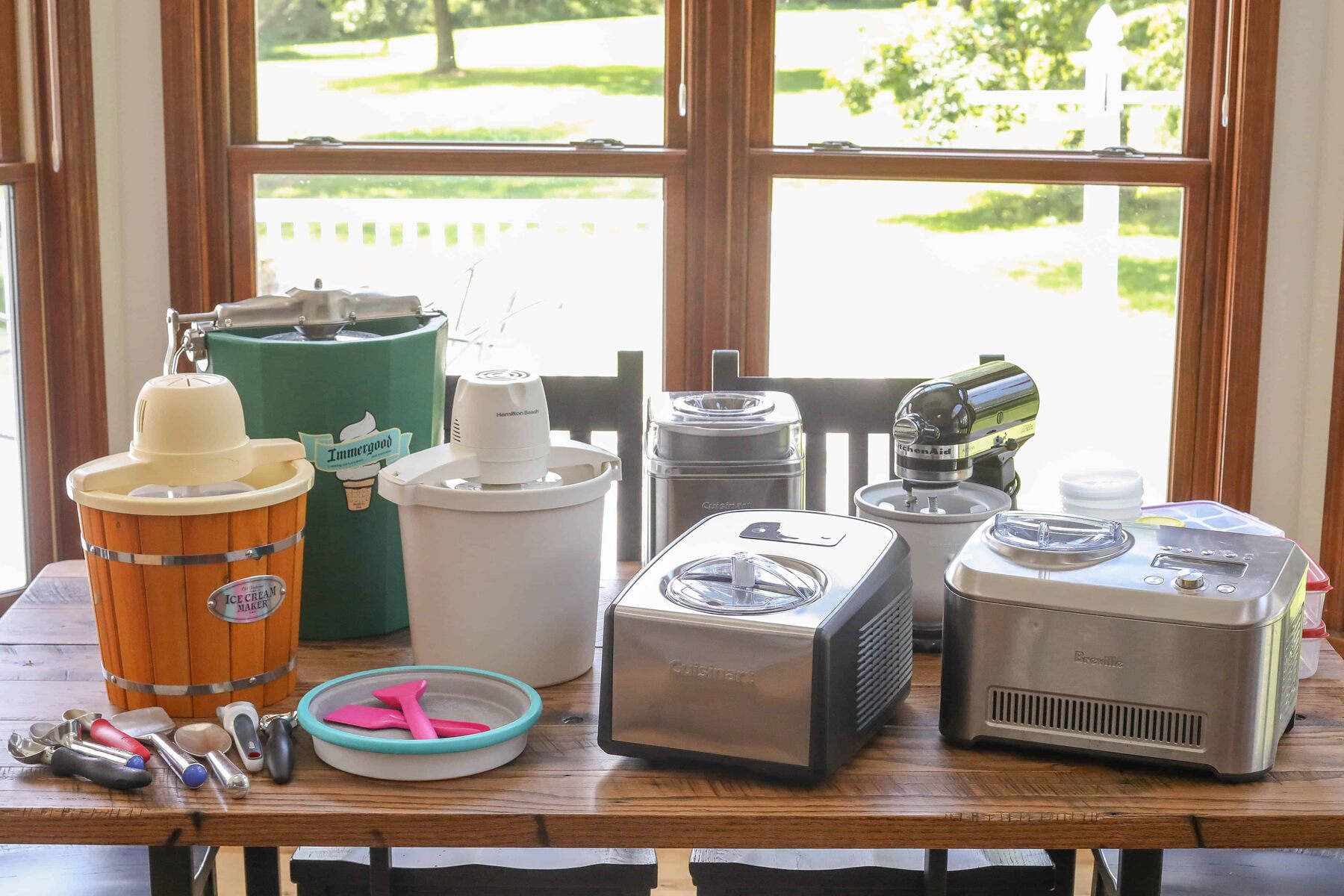Introduction
Nothing beats the classic taste of homemade ice cream. While modern ice cream makers may offer convenience, there’s something charming about using an old-fashioned ice cream maker. These vintage appliances allow you to connect with tradition and create delectable frozen treats from scratch.
In this guide, we will walk you through the process of using an old-fashioned ice cream maker to churn out creamy and indulgent ice cream at home. Whether you’re a seasoned ice cream enthusiast or new to the world of homemade frozen desserts, this step-by-step tutorial will ensure your success.
Using an old-fashioned ice cream maker may seem daunting, but fear not! With a little patience and some basic ingredients, you’ll be able to savor the nostalgic taste of homemade ice cream in no time.
Before we dive into the process, it’s important to note that old-fashioned ice cream makers typically consist of a hand crank, a metal canister for the ice cream mixture, and an outer bucket filled with ice and rock salt. The ice and salt mixture creates a freezing environment that allows the mixture to slowly churn and thicken into ice cream.
Now, let’s embark on a delicious journey as we explore the steps to use an old-fashioned ice cream maker and indulge in the sweet rewards.
Step 1: Assemble the Ice Cream Maker
The first step in using an old-fashioned ice cream maker is to assemble all the necessary components. Start by ensuring that you have all the parts of the ice cream maker, including the metal canister, the hand crank, the outer bucket, and any other accessories that may come with your specific model.
To assemble the ice cream maker, begin by placing the metal canister into the outer bucket. Make sure it fits securely and sits firmly in place. Next, attach the hand crank to the top of the canister, ensuring that it is properly aligned and securely attached.
If your ice cream maker has a lid or cover, place it on top of the canister, making sure it fits snugly. This will help prevent any ice or salt from entering the ice cream mixture as it churns.
Once the ice cream maker is assembled, double-check that all the parts are securely in place. Ensure the hand crank moves freely and smoothly. Any loose or faulty connections may hinder the churning process and affect the final result.
Now that you have assembled the ice cream maker, you’re one step closer to enjoying homemade ice cream. In the next step, we will guide you through preparing the ice cream mixture and getting it ready for the churning process.
Step 2: Prepare the Ice Cream Mixture
Now that your old-fashioned ice cream maker is assembled, it’s time to prepare the delicious ice cream mixture. The key to creamy and flavorful ice cream lies in choosing the right ingredients and achieving the perfect balance of flavors.
Start by selecting your desired ice cream recipe or flavor. You can opt for classic vanilla, decadent chocolate, fruity options like strawberry or mango, or even experiment with unique combinations like cookies and cream or salted caramel.
Once you have chosen your flavor, gather the necessary ingredients. Typically, an ice cream mixture consists of heavy cream, whole milk, sugar, and any flavorings or mix-ins you desire. Follow the recipe guidelines or create your own by adjusting ratios to achieve your preferred richness and sweetness.
In a large mixing bowl, combine the heavy cream, milk, and sugar. Whisk until the sugar is fully dissolved and the mixture is well combined. If your recipe calls for any additional flavorings, such as vanilla extract or cocoa powder, add them at this stage and mix thoroughly.
After combining the ingredients, taste the mixture and adjust the sweetness or flavorings, if needed, to suit your preferences. Remember that the flavors may intensify after the ice cream is churned and frozen, so it’s best to slightly under-sweeten the mixture.
Once you are satisfied with the taste of the ice cream mixture, cover the bowl and put it in the refrigerator to chill for at least an hour. Chilling the mixture helps the flavors meld together and makes it easier for the ice cream maker to freeze and churn the mixture.
With the ice cream mixture prepared and chilled, you are ready to move on to the next step – pre-chilling the ice cream maker. This crucial step ensures optimal freezing conditions for the mixture and promotes smooth churning and freezing of the ice cream.
Step 3: Pre-Chill the Ice Cream Maker
Before you start churning the ice cream mixture, it’s essential to pre-chill the old-fashioned ice cream maker. Pre-chilling creates a cold environment that allows the mixture to freeze properly and results in a smoother and creamier ice cream texture.
To pre-chill the ice cream maker, begin by removing the metal canister from the outer bucket assembly. Make sure to handle the canister with care as it may be cold from previous use or storage.
Once the canister is removed, rinse it with cold water to clear any residual ice cream or debris. This step ensures that the canister is clean and ready for the new batch of ice cream.
After rinsing, dry the canister thoroughly. You can use a clean kitchen towel or allow it to air dry. Make sure there is no moisture left on the surface as it can affect the freezing process.
Next, place the clean and dry canister back into the outer bucket. Ensure that it fits snugly and securely in place.
Now it’s time to prepare the freezing mixture. You will need a combination of ice and rock salt. The rock salt lowers the freezing point of the ice, creating a freezing environment inside the ice cream canister.
Start by layering a generous amount of ice into the outer bucket. Then, sprinkle a layer of rock salt over the ice. Repeat this process, alternating layers of ice and rock salt until the bucket is almost full.
Make sure to check the manufacturer’s instructions or the recommended ice-to-salt ratio for your specific ice cream maker model. This information will help you achieve the optimal freezing conditions.
Once the mixture of ice and rock salt is prepared, place the canister back into the bucket filled with the freezing mixture. Ensure that the canister is fully surrounded by the ice and salt mixture.
Allow the ice cream maker to sit undisturbed for a few minutes to ensure that the freezing mixture starts to work its magic.
By pre-chilling the ice cream maker and creating a freezing environment, you’re setting the stage for perfectly frozen and delicious homemade ice cream. In the next step, we will guide you through the process of adding the ice cream mixture to the canister and beginning the churning process.
Step 4: Add the Mixture to the Ice Cream Maker
With the ice cream maker pre-chilled and the freezing mixture prepared, it’s time to add the ice cream mixture to the canister and begin the churning process.
Retrieve the chilled ice cream mixture from the refrigerator, and give it a quick stir to ensure it’s well-mixed. Then, pour the mixture into the canister of the ice cream maker.
Be mindful not to overfill the canister, as the mixture will expand as it freezes and churns. Leave some space at the top to allow for expansion during the churning process. Typically, filling the canister to around two-thirds of its capacity is sufficient.
Once the mixture is added, place the lid or cover securely on top of the canister to prevent any ice or salt from entering the mixture. This ensures that your ice cream remains pristine and free from any unwanted particles or contamination.
Double-check that all the components are properly assembled and secured. Make sure that the hand crank is attached securely to the canister.
Now that the ice cream mixture is in place, it’s time to move on to the exciting part – churning the mixture to transform it into creamy, frozen goodness!
No old-fashioned ice cream maker can operate without proper cranking. So, grab hold of the hand crank and get ready to embark on a delightful churning experience.
In the next step, we will guide you through the process of starting the churn and monitoring the churning process to achieve the perfect consistency.
Step 5: Start Churning
With the ice cream mixture in the canister and all the components assembled, it’s time to begin the churning process. Churning is the transformative step where the mixture turns from a liquid state into creamy ice cream.
Start by securing the canister back into the outer bucket filled with the ice and rock salt mixture. Ensure that the canister is placed properly and that the freezing mixture surrounds it.
Once the canister is in place, you can start cranking the handle. Hold onto the hand crank firmly and turn it in a steady, clockwise motion. The churning process requires consistent and even cranking to achieve optimal results.
As you turn the hand crank, you will feel some resistance as the ice cream mixture begins to freeze. This is a sign that the churning process is underway. Keep cranking at a moderate pace to maintain a consistent churning rhythm.
Churning can take anywhere from 15 to 30 minutes, depending on various factors such as the recipe, the temperature of the freezing mixture, and the desired consistency. Follow the recipe guidelines or keep an eye on the texture and consistency as you churn.
During the churning process, check the ice and rock salt mixture surrounding the canister. If necessary, add more ice or rock salt to maintain the freezing environment. Ensure that the level of the freezing mixture does not drop below the canister.
As time passes, you will notice the ice cream mixture thickening and transforming into a creamy consistency. Take occasional breaks to check the texture and taste as it churns. This allows you to adjust the churning time based on your desired firmness and flavor.
Remember, practice makes perfect when it comes to churning. With each batch, you will gain a better understanding of the timing and consistency that work best for your preferences.
Once the ice cream reaches your desired consistency, it’s time to move on to the next step – adding mix-ins to customize your frozen treat (optional).
Now that you have successfully churned the ice cream mixture, you’re on your way to enjoying a delightful frozen dessert. In the next step, we will explore the option of adding mix-ins to take your homemade ice cream to the next level.
Step 6: Add Mix-ins (Optional)
One of the joys of making homemade ice cream is the ability to customize it with delicious mix-ins. Adding mix-ins not only enhances the flavor but also adds texture and visual appeal to your frozen creation. From chunks of chocolate or fruit to swirls of caramel or cookie dough, the possibilities are endless.
If you choose to incorporate mix-ins into your ice cream, there are a few methods you can try. One option is to add the mix-ins during the last few minutes of churning. Simply pause the churning process, sprinkle or drizzle your desired mix-ins into the partially frozen ice cream, and then resume churning for another minute or two. This allows the mix-ins to distribute evenly throughout the ice cream.
An alternative method is to layer the mix-ins during the transfer to the freezer container. Once you’ve finished churning, remove the canister from the ice cream maker. Scoop a layer of the freshly churned ice cream into a freezer-safe container, followed by a layer of your chosen mix-ins. Repeat this process until all the ice cream and mix-ins are layered in the container. This method creates ribbons or pockets of flavor and ensures that the mix-ins are evenly distributed.
Popular mix-in options include chocolate chips, nuts, cookie crumbs, crushed candies, fresh fruit chunks, and even swirls of fudge or caramel sauce. Get creative and experiment with different combinations to discover your personal favorite.
Remember, adding mix-ins is optional. If you prefer plain, unadulterated ice cream, you can skip this step and move on to the next one. The beauty of homemade ice cream is that you have complete control over the flavor profile.
Once you’ve added the desired mix-ins, it’s time to move on to the next step – transferring the freshly churned ice cream into a freezer container and preparing it for the final freezing process.
With mix-ins incorporated, your homemade ice cream is now a truly unique and decadent treat. In the next step, we will guide you through the process of transferring the ice cream and preparing it for the final freezing stage.
Step 7: Monitor the Churning Process
Monitoring the churning process of your ice cream is crucial to achieving the perfect texture and consistency. Keeping a close eye on the progress allows you to make necessary adjustments and ensure a smooth and creamy outcome.
As the ice cream churns, it’s important to monitor the speed and rhythm of the churning. Keep the hand crank moving steadily and consistently, without exerting too much force. This helps to evenly distribute the freezing temperature and air throughout the mixture.
Additionally, observe the appearance of the ice cream as it churns. At the beginning of the process, the mixture may look liquid-like, but as it continues to churn, it will gradually thicken and become more solid. You want to aim for a soft-serve consistency, where the mixture holds its shape but is still creamy and pliable.
Take occasional breaks from cranking to check the texture and consistency. Use a long spoon or spatula to scoop a small amount of the mixture from the canister. Observe how it holds its shape and if it has a smooth and creamy texture.
If the ice cream appears too soft, continue churning for a few more minutes. On the other hand, if it becomes too firm, it may be over-churned. In this case, you can add a small amount of chilled milk or cream to soften the mixture and achieve the desired texture.
Remember that the churning time can vary depending on factors such as the recipe, temperature, and personal preference. Refer to the recipe guidelines, but also trust your instincts and judgment. The more you make homemade ice cream, the better you will become at recognizing the ideal consistency.
Lastly, be mindful of any condensation that forms on the outside of the canister. This is a sign that the ice cream is nearing completion, as the cold temperature causes moisture in the air to condense on the surface. It’s an exciting indication that your ice cream is almost ready to be enjoyed!
By closely monitoring the churning process, you can ensure that your homemade ice cream turns out just right. In the next step, we will guide you through transferring the churned ice cream to a freezer container for the final freezing phase.
Step 8: Transfer to a Freezer Container
Once you have achieved the desired consistency and texture during the churning process, it’s time to transfer the freshly churned ice cream into a freezer container. This step sets the stage for the final freezing phase, where the ice cream will solidify and develop its full flavor and creaminess.
Start by carefully removing the canister from the ice cream maker. Place it on a stable and clean surface. Avoid shaking or tilting the canister to prevent any ice cream spillage.
Using a rubber spatula or a large spoon, scoop the churned ice cream from the canister into a freezer-safe container. Make sure to work quickly to minimize any meltage.
Smooth the surface of the ice cream using the back of the spoon or spatula. This helps to create an even and well-packed layer in the container.
For additional protection against freezer burn and to maintain the quality of the ice cream, place a piece of parchment paper or plastic wrap directly on the surface of the ice cream. This creates a barrier between the ice cream and any air in the container.
Seal the container tightly with a lid or wrap it securely with plastic wrap. This helps to prevent any air from entering and damaging the texture and flavor of the ice cream.
Remember to label the container with the flavor and the date of preparation. This way, you can keep track of the different batches of ice cream and consume them within a reasonable timeframe.
Once the ice cream is in the freezer container, transfer it to the coldest part of your freezer. This ensures that it freezes quickly and thoroughly.
Allow the ice cream to freeze for a minimum of 4 hours or, preferably, overnight. During this time, the ice cream will solidify and mature, developing its full flavor and creamy texture.
Now, with the ice cream safely transferred to a freezer container, it’s time to move on to the final step – freezing the ice cream and getting ready to enjoy your homemade frozen delight!
Step 9: Freeze the Ice Cream
Now that you have transferred the freshly churned ice cream into a freezer container, it’s time for the final step – freezing the ice cream. This crucial step allows the ice cream to fully set and develop its rich and creamy texture.
Place the sealed container of ice cream into the coldest part of your freezer. Ensure that it is placed on a level surface to prevent any unnecessary shifting or tilting.
Allow the ice cream to freeze undisturbed for a minimum of 4 hours or, ideally, overnight. During this time, the mixture will solidify and the flavors will fully merge, resulting in a delicious and satisfying frozen treat.
It’s important to note that the freezing time may vary based on factors such as the temperature of your freezer and the specific recipe. Consult your recipe guidelines for recommended freezing durations.
Resist the temptation to repeatedly open the freezer door to check on the ice cream, as this can cause fluctuations in temperature and affect the freezing process.
Once the ice cream is fully frozen, remove it from the freezer and allow it to sit at room temperature for a few minutes to soften slightly. This makes scooping easier and ensures a smooth and creamy texture.
Use an ice cream scoop or a spoon to portion out the frozen delight into bowls, cones, or dishes. Garnish with your favorite toppings, such as chocolate sauce, sprinkles, or fresh fruit, to take it to the next level.
Remember to store any unused portions of the ice cream in the freezer, tightly sealed, to maintain its quality and freshness.
Finally, sit back, relax, and indulge in the fruits of your labor. Enjoy the satisfaction of savoring a scoop of homemade ice cream that you created from scratch using the traditional method.
By following this step-by-step process, you can enjoy the delectable results of your old-fashioned ice cream maker. So go ahead and delight your taste buds with the creamy, homemade goodness of your very own ice cream creation!
Conclusion
Using an old-fashioned ice cream maker may require a bit of effort, but the rewards are well worth it. From the nostalgic charm to the creamy and indulgent homemade ice cream, the experience of making your frozen treats from scratch is unmatched.
In this guide, we have taken you through the step-by-step process of using an old-fashioned ice cream maker. From assembling the ice cream maker to pre-chilling the machine, preparing the ice cream mixture, and finally freezing the ice cream to perfection, each step contributes to the final outcome – a delightful and custom-made frozen dessert.
Through careful monitoring of the churning process, adding mix-ins to personalize your creation, and transferring the ice cream to a freezer container, you have gained the knowledge and confidence to embark on your ice cream-making adventures. The possibilities are endless, allowing you to create an array of flavors and textures to suit your preferences.
So, whether you’re making classic vanilla, rich chocolate, or indulging in exciting flavor combinations, using an old-fashioned ice cream maker allows you to connect with tradition and create memories with loved ones.
Don’t be afraid to experiment and explore new recipes and mix-ins. With each batch, you will refine your technique and discover your own signature creations. The joy and satisfaction of seeing your family and friends indulge in your homemade ice cream are truly unmatched.
So go ahead, dust off that old-fashioned ice cream maker, and let your creativity flow. Embrace the process, enjoy the journey, and savor the delicious rewards of homemade ice cream made with love.
Now that you have all the knowledge and steps at your disposal, it’s time to unleash your inner ice cream master and start churning out frozen delights that will leave everyone craving for more!







